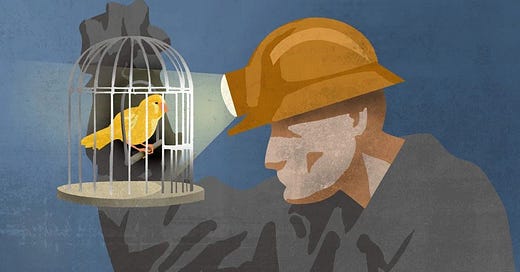Was the collapse of Silicon Valley Bank and Signature Bank a warning sign of the banking crisis? It's possible, as the Federal Reserve and Treasury Department may have contained the problem so far, but more challenges could arise in the future. In this report, we'll explore the issue further.
In the Global Financial Crisis, the failure of two hedge funds managed by Bear Stearns was the "canary in the coal mine" that triggered a contagion in the investment banking sector, leading to the ultimate demise of Lehman Brothers. When JP Morgan acquired Bear Stearns at a bargain price of $10 per share, they soon regretted the decision, as CEO Jamie Dimon admitted, "We thought we were buying a house, but we didn't realize it was a house on fire."
The expression "canary in the coal mine" originated in the early 1900s when coal miners in Britain brought canaries with them into the mines as a warning system against odorless poisonous gases that could kill them. Because the small birds had a faster metabolism, they would show the effects of carbon monoxide before the deadly gas could harm the miners.
Protecting small and modest depositors up to a certain level has been a longstanding practice in the US, dating back to the creation of the Federal Deposit Insurance Corporation (FDIC) in 1934. Originally, the FDIC covered $5,000 per account, which was increased to $100,000 by 1980 and has remained at $250,000 for a long time. When SVB collapsed, there was concern that depositors were limited to this insured limit, but authorities quickly changed the laws to make depositors whole with SVB and Signature Bank. The reason was to prevent systemic risk and a total collapse of the banking system. However, this action may not have resolved the underlying issue.
At a recent Senate hearing, an Oklahoma senator asked Treasury Secretary Janet Yellen whether her actions with SVB meant that all regional banks' depositors in his constituency would also be made whole in the event of a bank run. Yellen could not give a clear-cut reply, stating that it would depend on a case-by-case basis determined by the FDIC, Fed, Treasury, and White House. The FDIC reports that there are over 4,800 insured commercial banks in the US, with 30 banks each having assets in the range of $50 to $250 billion holding an average of only 7% cash from early 2023, down from 13% the previous year. In contrast, the largest banks in the US, such as JP Morgan and Citigroup, hold an average of 15% of their assets in cash, thanks to fractional banking.
The main reason for concern is that the Fed has hiked rates well above expected levels in the shortest period of time in history. It wasn't necessarily the magnitude of the hikes but the speed at which they occurred that caused the problem. Furthermore, the Fed is still not finished hiking rates. Despite the rise in interest rates, banks offer less than 0.25% a year for deposits, except for those with $25 million or more, who can receive 3%. The Fed funds rate is now at 5%, and three-month US Treasuries yield 4.8375%. Why aren't banks offering 3 or 4% deposit rates to their customers? They should, but they can't.
As we learned from the collapse of SVB, banks were incentivized to purchase safe US Treasuries over the last two years, with many opting for longer-duration Treasuries to capture higher yields in a low-interest-rate environment. Now, with interest rates having moved up, all those investments are deep underwater, causing massive liquidity problems. The implementation of the Bank Term Funding Program (BTFP) has provided liquidity to many regional banks to prevent them from collapsing due to liquidity problems like those experienced by SVB. The BTFP enables regional banks to swap their long-duration Treasuries for cash at face value, which provides them with the liquidity they need to deal with capital outflows happening in real-time.
However, this newfound liquidity is being used by banks to keep depositors whole and return deposits to those who want to leave the bank. Banks cannot afford to pay higher deposit rates because they need capital for operating expenses. Banks technically need to pay back the cash loans they received through the BTFP and get their long-duration US Treasuries back on their books within a year's time, which raises questions about how that will play out. The Fed makes up the rules depending on the situation.
Currently, capital is fleeing the banking system, exacerbating the liquidity problem and causing even more problems for the banking sector. Depositors are moving their money into money market funds, which will be the catalyst for even more support and stimulus from the US government to prevent the entire system from collapsing.
Will this stop the Fed from hiking further? It's not clear. The Fed may make the same mistake of delaying the hike when they should have hiked, and now the same thing may be happening in reverse. Although I believe they shouldn't have hiked last time, they may do it again on May 03 by another 25 basis points. When it comes to policies, it seems like the Fed has taken a "path of least embarrassment."
If you received value from this post, and you’d like to send some back, or if you’d like to signal to me to continue spending time on these types of explorations, feel free to buy me coffees (thank you!):
So, there we go. Thanks for reading Breezy Briefings. If you enjoyed this, I'd really appreciate it if you could take a second and tell a friend. Honestly. It makes such a big difference.
Forward this email. Recommend the newsletter. Share on Twitter, WhatsApp, Telegram, LinkedIn, Slack, wherever!
Join Breezy Briefings’ Official Telegram Channel: https://t.me/BreezyBriefings
Abraham George is a seasoned investment manager with more than 40 years of experience in trading & investment and multi-billion dollar portfolio management spanning diverse environments like banks (HSBC, ADCB), sovereign wealth fund (ADIA), a royal family office, and a hedge fund.



